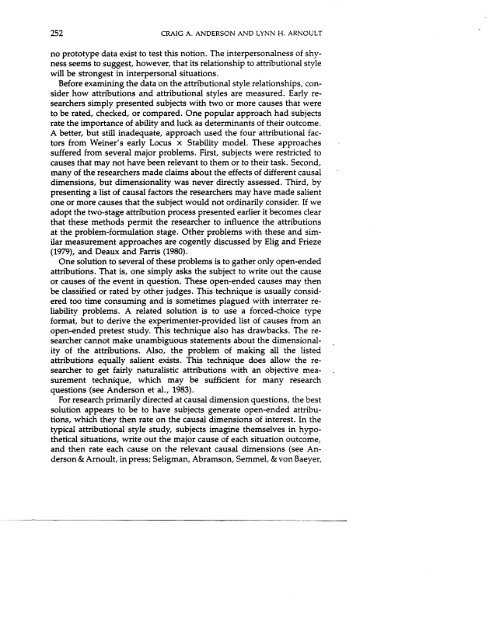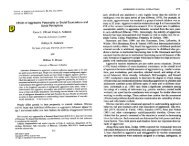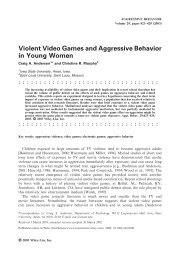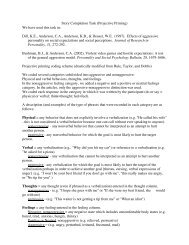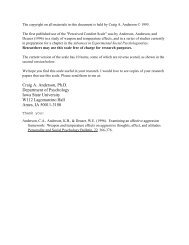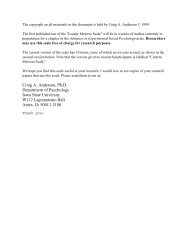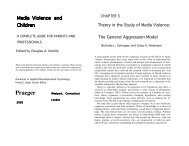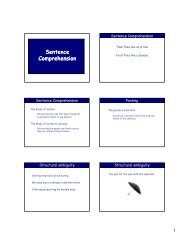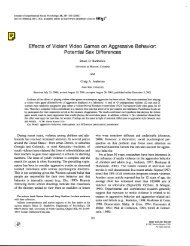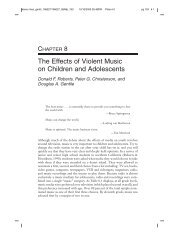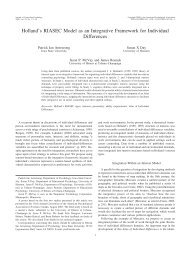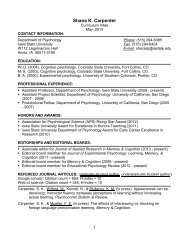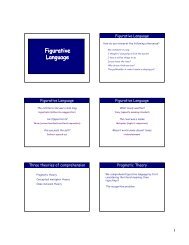Attributional Models of Depression, Loneliness, and Shyness
Attributional Models of Depression, Loneliness, and Shyness
Attributional Models of Depression, Loneliness, and Shyness
Create successful ePaper yourself
Turn your PDF publications into a flip-book with our unique Google optimized e-Paper software.
252 CRAIG A. ANDERSON AND LYNN H. ARNOULT<br />
no prototype data exist to test this notion. The interpersonalness <strong>of</strong> shyness<br />
seems to suggest, however, that its relationship to attributional style<br />
will be strongest in interpersonal situations.<br />
Before examining the data on the attributional style relationships, consider<br />
how attributions <strong>and</strong> attributional styles are measured. Early researchers<br />
simply presented subjects with two or more causes that were<br />
to be rated, checked, or compared. One popular approach had subjects<br />
rate the importance <strong>of</strong> ability <strong>and</strong> luck as determinants <strong>of</strong> their outcome.<br />
A better, but still inadequate, approach used the four attributional factors<br />
from Weiner's early Locus x Stability model. These approaches<br />
suffered from several major problems. First, subjects were restricted to<br />
causes that may not have been relevant to them or to their task. Second,<br />
many <strong>of</strong> the researchers made claims about the effects <strong>of</strong> different causal<br />
dimensions, but dimensionality was never directly assessed. Third, by<br />
presenting a list <strong>of</strong> causal factors the researchers may have made salient<br />
one or more causes that the subject would not ordinarily consider. If we<br />
adopt the two-stage attribution process presented earlier it becomes clear<br />
that these methods permit the researcher to influence the attributions<br />
at the problem-formulation stage. Other problems with these <strong>and</strong> similar<br />
measurement approaches are cogently discussed by Elig <strong>and</strong> Frieze<br />
(1979), <strong>and</strong> Deaux <strong>and</strong> Farris (1980).<br />
One solution to several <strong>of</strong> these problems is to gather only open-ended<br />
attributions. That is, one simply asks the subject to write out the cause<br />
or causes <strong>of</strong> the event in question. These open-ended causes may then<br />
be classified or rated by other judges. This technique is usually considered<br />
too time consuming <strong>and</strong> is sometimes plagued with interrater reliability<br />
problems. A related solution is to use a forced-choice type<br />
format, but to derive the experimenter-provided list <strong>of</strong> causes from an<br />
open-ended pretest study. This technique also has drawbacks. The researcher<br />
cannot make unambiguous statements about the dimensionality<br />
<strong>of</strong> the attributions. Also, the problem <strong>of</strong> making all the listed<br />
attributions equally salient exists. This technique does allow the researcher<br />
to get fairly naturalistic attributions with an objective measurement<br />
technique, which may be sufficient for many research<br />
questions (see Anderson et al., 1983).<br />
For research primarily directed at causal dimension questions, the best<br />
solution appears to be to have subjects generate open-ended attributions,<br />
which they then rate on the causal dimensions <strong>of</strong> interest. In the<br />
typical attributional style study, subjects imagine themselves in hypothetical<br />
situations, write out the major cause <strong>of</strong> each situation outcome,<br />
<strong>and</strong> then rate each cause on the relevant causal dimensions (see Anderson<br />
& Amoult, in press; Seligman, Abramson, Semmel, &von Baeyer,


